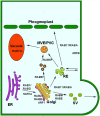The regulatory RAB and ARF GTPases for vesicular trafficking
- PMID: 18678743
- PMCID: PMC2492611
- DOI: 10.1104/pp.108.121798
The regulatory RAB and ARF GTPases for vesicular trafficking
Figures



Similar articles
-
Vesicular traffic: an integral part of plant life.Curr Opin Plant Biol. 2002 Dec;5(6):513-7. doi: 10.1016/s1369-5266(02)00299-6. Curr Opin Plant Biol. 2002. PMID: 12393014 Review.
-
The role of ARF and Rab GTPases in membrane transport.Curr Opin Cell Biol. 1999 Aug;11(4):466-75. doi: 10.1016/S0955-0674(99)80067-2. Curr Opin Cell Biol. 1999. PMID: 10449335 Review.
-
Rab proteins and the compartmentalization of the endosomal system.Cold Spring Harb Perspect Biol. 2014 Oct 23;6(11):a022616. doi: 10.1101/cshperspect.a022616. Cold Spring Harb Perspect Biol. 2014. PMID: 25341920 Free PMC article. Review.
-
[Rab small GTPases and their effectors].Tanpakushitsu Kakusan Koso. 2008 Dec;53(16 Suppl):2065-70. Tanpakushitsu Kakusan Koso. 2008. PMID: 21038586 Review. Japanese. No abstract available.
-
The Rab family of proteins: 25 years on.Biochem Soc Trans. 2012 Dec 1;40(6):1337-47. doi: 10.1042/BST20120203. Biochem Soc Trans. 2012. PMID: 23176478
Cited by
-
Extracellular vesicle formation in Euryarchaeota is driven by a small GTPase.Proc Natl Acad Sci U S A. 2024 Mar 5;121(10):e2311321121. doi: 10.1073/pnas.2311321121. Epub 2024 Feb 26. Proc Natl Acad Sci U S A. 2024. PMID: 38408251 Free PMC article.
-
Identification and differential expression dynamics of peach small GTPases encoding genes during fruit development and ripening.J Exp Bot. 2010 Jun;61(10):2829-42. doi: 10.1093/jxb/erq116. Epub 2010 May 25. J Exp Bot. 2010. PMID: 20501747 Free PMC article.
-
The Golgi Apparatus and its Next-Door Neighbors.Front Cell Dev Biol. 2022 Apr 28;10:884360. doi: 10.3389/fcell.2022.884360. eCollection 2022. Front Cell Dev Biol. 2022. PMID: 35573670 Free PMC article. Review.
-
Protease inhibitor ASP enhances freezing tolerance by inhibiting protein degradation in kumquat.Hortic Res. 2023 Feb 16;10(4):uhad023. doi: 10.1093/hr/uhad023. eCollection 2023 Apr. Hortic Res. 2023. PMID: 37786860 Free PMC article.
-
Interaction of a Blumeria graminis f. sp. hordei effector candidate with a barley ARF-GAP suggests that host vesicle trafficking is a fungal pathogenicity target.Mol Plant Pathol. 2014 Aug;15(6):535-49. doi: 10.1111/mpp.12110. Epub 2014 Mar 3. Mol Plant Pathol. 2014. PMID: 24304971 Free PMC article.
References
-
- Anai T, Matsui M, Nomura N, Ishizaki R, Uchimiya H (1994) In vitro mutation analysis of Arabidopsis thaliana small GTP-binding proteins and detection of GAP-like activities in plant cells. FEBS Lett 346 175–180 - PubMed
-
- Aniento F, Robinson DG (2005) Testing for endocytosis in plants. Protoplasma 226 3–11 - PubMed
-
- Barlowe C, Schekman R (1993) SEC12 encodes a guanine-nucleotide-exchange factor essential for transport vesicle budding from the ER. Nature 365 347–349 - PubMed
Publication types
MeSH terms
Substances
LinkOut - more resources
Full Text Sources

